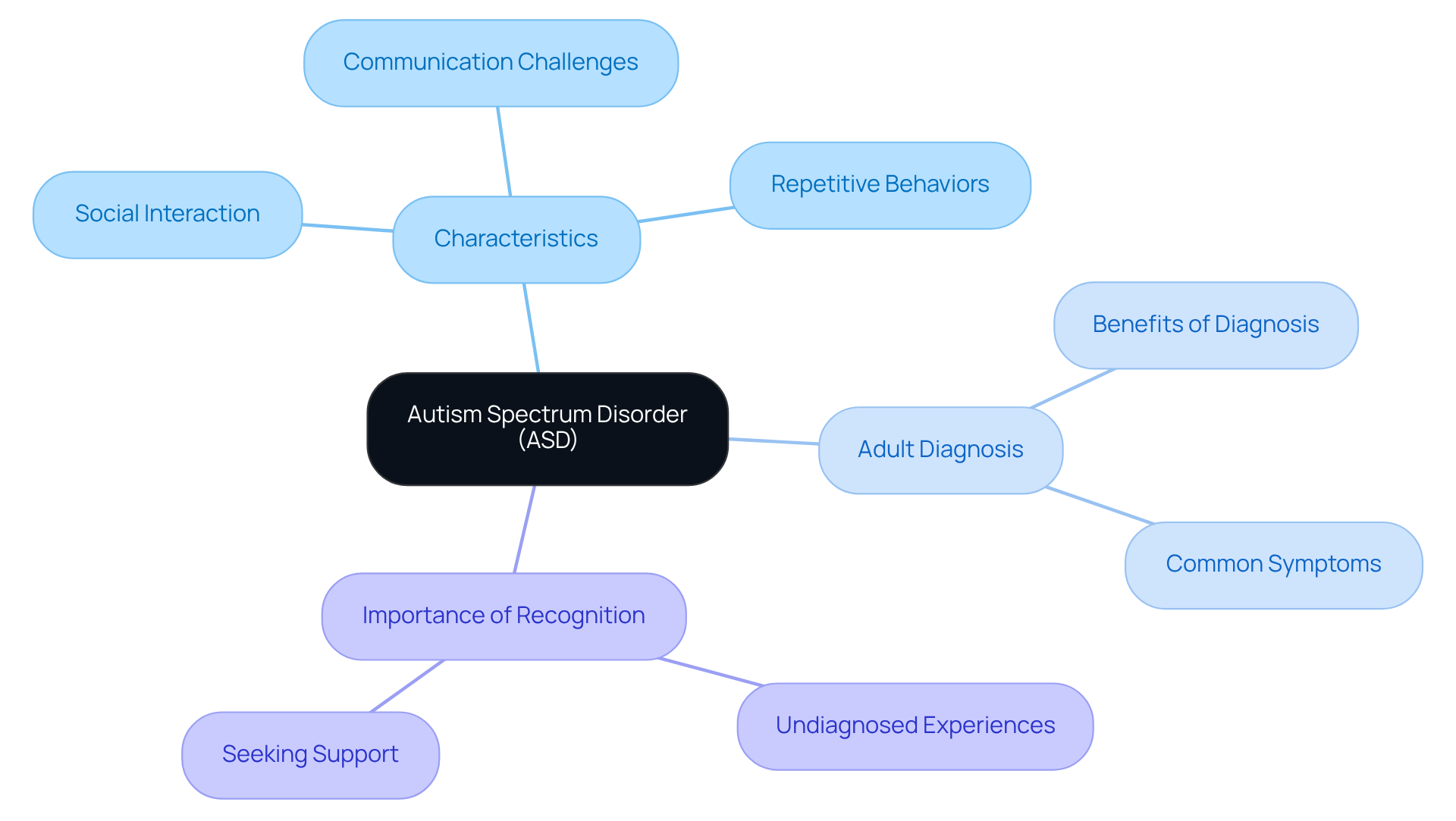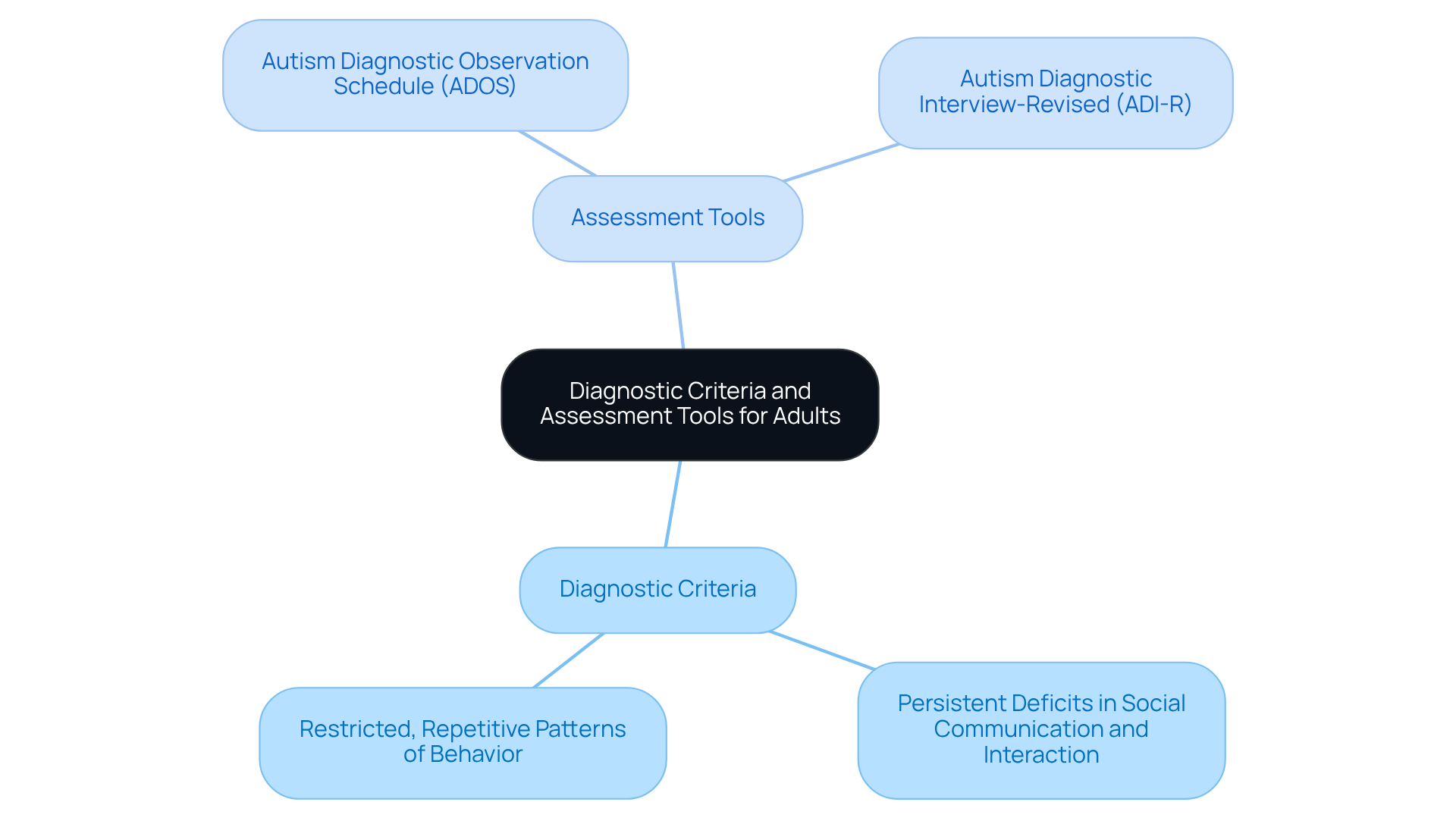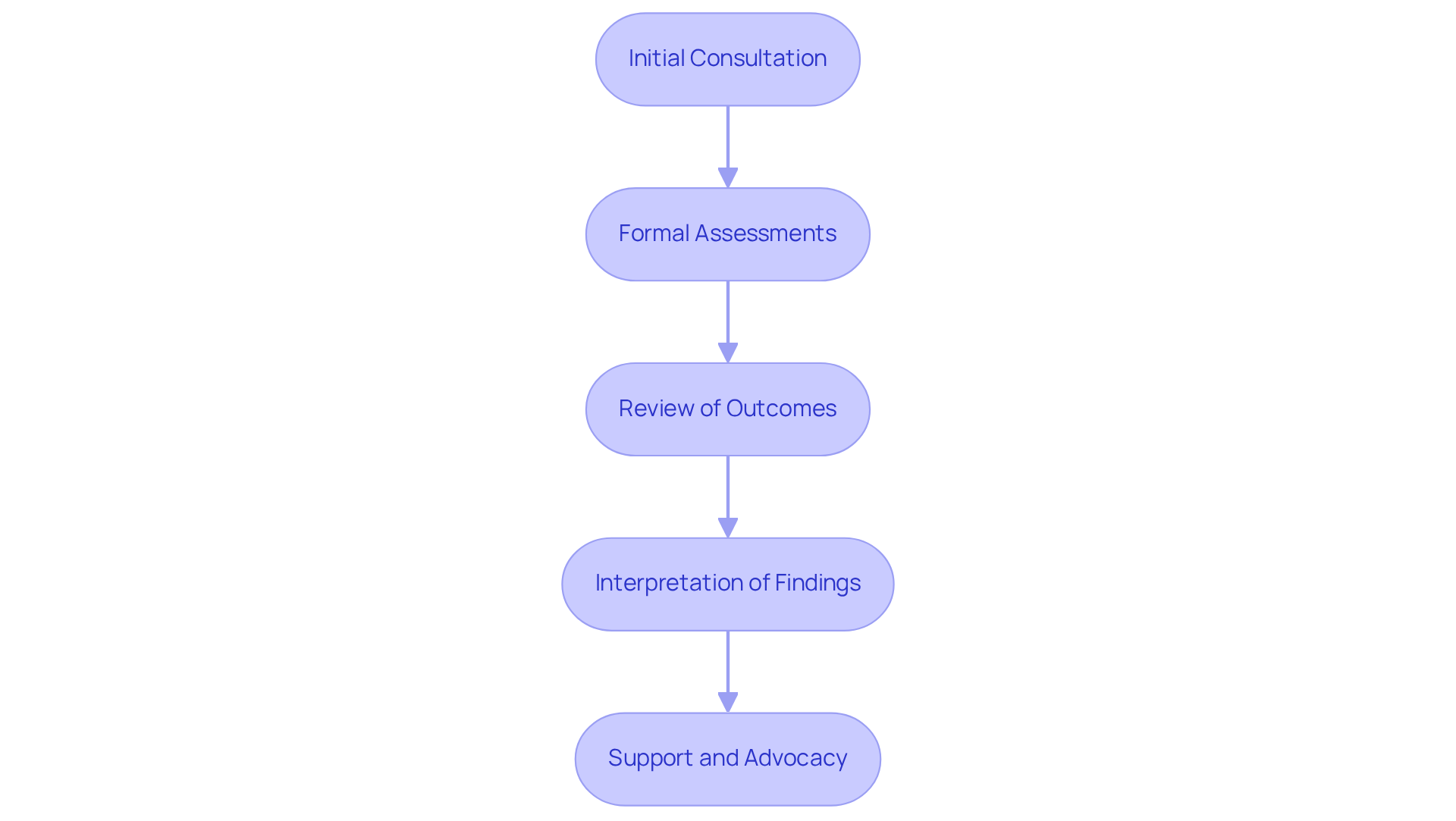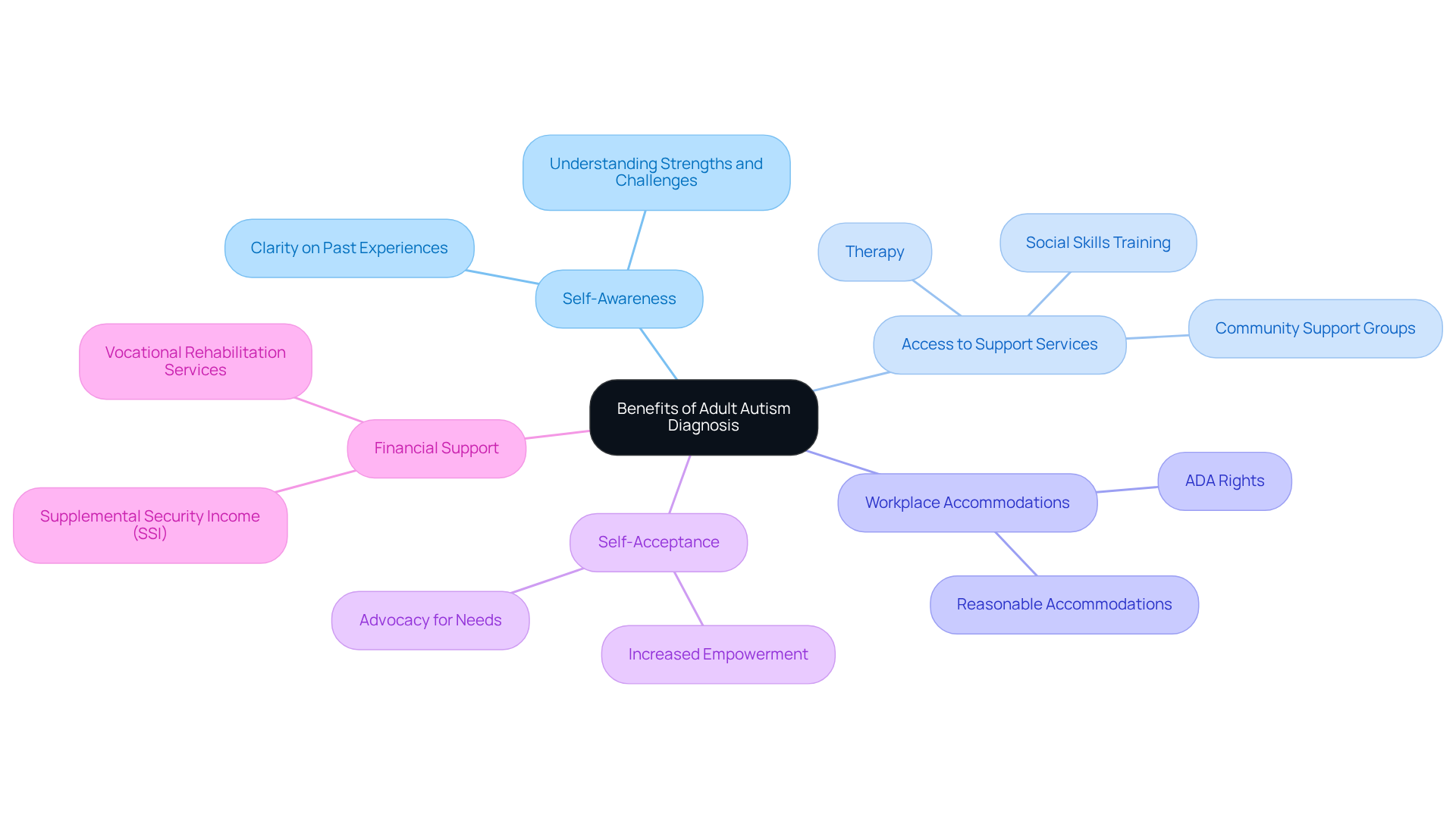Overview
Understanding the process of testing for adult autism is vital. It involves grasping the diagnostic criteria, engaging in structured assessments, and interpreting the results. This journey can lead to greater self-awareness and open doors to valuable support services. A diagnosis can illuminate past experiences and challenges, providing clarity that many seek. This newfound understanding can significantly enhance quality of life, offering tailored resources and fostering community support.
If you or someone you know is navigating this path, consider reaching out for guidance and assistance. You are not alone, and there are compassionate resources available to help you thrive.
Introduction
Understanding Autism Spectrum Disorder (ASD) in adults is essential, as many individuals remain undiagnosed, facing challenges in social interaction and communication that can profoundly affect their lives. Obtaining a diagnosis can unlock vital support and resources, offering clarity and a pathway to deeper self-understanding. Yet, this journey often brings uncertainty—what does the testing process involve, and how can one navigate it effectively? By exploring these questions, we can uncover the transformative benefits of adult autism assessments, empowering individuals to take the first step toward understanding their unique experiences.
Clarify Autism Spectrum Disorder and Its Adult Diagnosis
Autism Spectrum Disorder (ASD) is a neurodevelopmental condition that presents unique challenges in social interaction, communication, and repetitive behaviors. Often identified in childhood, many individuals may remain undiagnosed, leading to a profound lack of understanding regarding their experiences. A mature diagnosis can offer clarity and open doors to essential support.
Understanding the spectrum is vital, as symptoms can vary greatly among individuals. This section will delve into what ASD truly means, explore its occurrence in adults, and underscore the importance of recognizing symptoms that may have gone unnoticed in childhood, particularly in the context of the test for adult autism. By shedding light on these aspects, individuals can gain a deeper understanding of their experiences and discover the potential benefits of pursuing a test for adult autism.
If you or someone you know resonates with these challenges, consider seeking support. You are not alone in this journey, and understanding your experiences can be the first step toward finding the help you deserve.

Examine Diagnostic Criteria and Assessment Tools for Adults
Understanding the diagnostic criteria for Autism Spectrum Disorder can be a crucial step for many families. Outlined in the Diagnostic and Statistical Manual of Mental Disorders, Fifth Edition (DSM-5), these criteria include:
- Persistent deficits in social communication and interaction
- Restricted, repetitive patterns of behavior
This knowledge can help parents feel more prepared and informed.
To assess individuals, professionals often use valuable tools like:
- The Autism Diagnostic Observation Schedule (ADOS)
- The Autism Diagnostic Interview-Revised (ADI-R)
These assessments involve structured interviews and observational techniques to gather comprehensive insights into an individual's behavior and history. Knowing about these tools can alleviate some of the anxiety surrounding the evaluation process.
For parents pursuing a diagnosis, comprehending the criteria and tools for the test for adult autism is essential. It not only readies them for the evaluation process but also helps them articulate their concerns and experiences effectively. Remember, you are not alone in this journey—support is available, and understanding these elements can empower you as you navigate the path ahead.

Navigate the Testing Process: What to Expect and How to Interpret Results
Starting the journey of adult autism testing can feel overwhelming, but it begins with a simple step: an initial consultation with a qualified professional, such as a psychologist or psychiatrist, for a test for adult autism. During this important meeting, individuals have the chance to share their concerns and personal experiences in a safe space. Following this, formal assessments will take place, which may include interviews, questionnaires, and observational assessments as part of the test for adult autism. It’s crucial to approach this process with an open mind and to be honest about your experiences.
After the evaluations, the outcomes will be reviewed, often providing insights or suggestions for additional support. Understanding how to interpret these findings is vital; remember, it’s perfectly okay to ask questions and seek clarification on any aspects that may be unclear. This section aims to guide you through each step, ensuring you know what to expect and how to advocate for yourself throughout the process. You are not alone in this journey, and support is available every step of the way.

Explore the Benefits of an Adult Autism Diagnosis
An autism assessment in adults, specifically a test for adult autism, can significantly enhance self-awareness, allowing individuals to better understand their behaviors and challenges. As Hallie Levine points out, "An ASD identification can help clarify why certain things, such as social interactions or bright lights, have always posed a challenge." This newfound clarity often leads to access to tailored support services, including therapy and social skills training, which can greatly improve quality of life.
Many adults express a profound sense of relief and affirmation upon receiving their assessment, as it helps them make sense of their past experiences and current difficulties. Furthermore, an assessment can assist in navigating workplace accommodations under the Americans with Disabilities Act (ADA), which provides individuals with specific rights and protections for a more inclusive environment.
Real-life examples show that those who receive a later-in-life assessment frequently experience increased self-acceptance and empowerment, enabling them to effectively advocate for their needs. Additionally, adults with ASD may qualify for Supplemental Security Income (SSI), offering financial support that can enhance their overall quality of life.
The advantages of an autism diagnosis extend beyond personal understanding; they include improved access to resources, community support groups, and ultimately foster a more fulfilling life. If you or someone you know is considering a test for adult autism, it could be a transformative step towards greater self-discovery and support.

Conclusion
Understanding the process of adult autism testing is essential for individuals seeking clarity about their experiences. A diagnosis of Autism Spectrum Disorder (ASD) in adulthood can shed light on previously unrecognized challenges and provide a pathway to vital support. By acknowledging the significance of this diagnosis, individuals can take proactive steps toward better self-understanding and access the resources they need.
This article delves into the various aspects of obtaining an autism diagnosis as an adult, highlighting the diagnostic criteria and assessment tools utilized by professionals. It outlines the testing process, emphasizing the importance of open communication during evaluations, and discusses the benefits that come with a diagnosis, such as improved self-awareness, access to tailored support services, and an enhanced quality of life. Each of these elements plays a crucial role in empowering individuals to navigate their unique journeys.
Ultimately, pursuing a test for adult autism can be a transformative experience, fostering self-acceptance and equipping individuals with the necessary tools to advocate for their needs. It is vital for individuals to recognize that they are not alone in this journey and that support is indeed available. Seeking a diagnosis can lead to a more fulfilling life, enriched by understanding and community resources. Taking that first step toward assessment can open doors to a brighter future.
Frequently Asked Questions
What is Autism Spectrum Disorder (ASD)?
Autism Spectrum Disorder (ASD) is a neurodevelopmental condition characterized by challenges in social interaction, communication, and the presence of repetitive behaviors.
When is ASD typically identified?
ASD is often identified in childhood, but many individuals may remain undiagnosed into adulthood.
Why is a mature diagnosis of ASD important?
A mature diagnosis can provide clarity about an individual's experiences and open doors to essential support that may have been lacking.
How do symptoms of ASD vary among individuals?
Symptoms of ASD can vary greatly among individuals, highlighting the importance of understanding the spectrum to recognize potentially unnoticed symptoms.
What should individuals do if they resonate with the challenges of ASD?
Individuals who identify with the challenges of ASD are encouraged to seek support, as understanding their experiences can be a crucial step toward finding the help they need.




